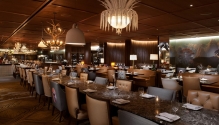The Izakaya Alchemy
As dining trends shift from formal to casual, Japanese izakayas, focusing on seasonality, are becoming popular hangouts for Indians. They present an opportunity for food-forward hotels and standalone outlets to capitalise on the growing interest in this unfussy dining style.
By Suman Tarafdar
Move aside sushi-sashimi.
The duo, which represented the cuisines of Japan in India for almost a couple of decades, is at last getting multiple support acts from a range of other dishes. With about 1,500 Japanese companies registered in India, and about 10,000 Japanese expats residing in the country, it is no wonder that the demand for Japanese restaurants has skyrocketed.
However, the popularity of izakayas is not limited to the Japanese in India. Indians, themselves, are experimenting with izakaya-style dining.
Significantly, while the earlier generation of best-known outlets serving Japanese tended to be in premium locations—usually within luxury hotels, such as Wasabi by Morimoto, Megu, San:Qi, Sakura and many others, a newer generation of outlets are more casual in look and feel, taking inspiration from the changes in Japan itself. Easily the most popular concept is that of the izakaya, a much more casual informal Japanese bar that is most often compared to an English pub. Comfort, unfussy food, meal bowls, shareable platters, beer… yes, but for geography, the concepts match considerably. In Japanese, izakaya translates to ‘stay-drink-place’ i.e. a place to enjoy a drink, eat a meal, and get comfortable!

At Shin'ya, the menu includes Maguro Tataki, Gindara Saikyo Yaki, Matcha Roulade and Kaisen Salad.

The most popular concept is that of the izakaya, a much more casual informal Japanese bar that is most often compared to an English pub.
One of the latest izakayas to open is Shin’ya at Hyatt Regency, Gurugram, which styles itself as a fresh dining concept set to revolutionise Japanese cuisine in Delhi NCR. It is unmistakably an izakaya but modulated to local preferences. “The restaurant is a place where people can come and unwind,” says Sonale Zagade, General Manager. “The soothing ambience, friendly well-trained staff, and the authentic Japanese gourmet spread heighten the izakaya experience.” Chef Adi Melaz, who helms the outlet, says it is ideal for friends to chill and have some food and drinks after work hours. Indeed, the izakaya is open only from about 6 pm to 10.30 pm after which it converts to a bar. The hotel, which is located in an area where a lot of Japanese expats stay, has an almost captive audience. Despite being inside a premium hotel, it aims to be affordable and has designed its menu accordingly.
Indeed, Delhi, Mumbai and Bengaluru have seen a profusion of izakaya-style restaurants. Chef David Myers opened his Japanese izakaya-style restaurant Adrift Kaya, JW Marriott, Delhi, a couple of years ago, to spread his love of Japanese culture. “I live in Tokyo as well, so I'm immersed in the very best cuisine in Japan, and I eat out almost every night. And that's my inspiration for everything I do here. So, I've experienced all the dishes you see here in some way or the other throughout Japan, and I love them.”
Myers is conscious that despite being inside a luxury hotel, he wanted to capture the flavour of an izakaya. “People love eating Japanese, and, you know, they appreciate that we're bringing our version of an authentic izakaya to Delhi,” he says. That authenticity also extends to the look and feel, from tatami-style seating to high bars and red lamps. “The need for authentic Japanese cuisine has grown manifold in recent years in India," says Kojiro Honda, Co-Owner & Founder, Kuuraku India. “Most of Kuuraku’s outlet locations cater to areas with significant Japanese presence and aim to offer a more authentic experience, with multiple elements of a typical izakaya woven in."
People just love eating Japanese, and, you know, they appreciate that we're bringing our version of an authentic izakaya to Delhi.
Chef David Myers
Adrift Kaya

Why izakayas?
Perhaps the greatest acceptance and popularity for the concept has come from outlets that have opened outside the luxury environs (though a note of caution here—Japan is one of the richest countries per capita, and just about everything is generally deemed as expensive by outsiders!). The approachability of an izakaya makes it popular; it's an informal space where one comes to unwind after a long day, reiterates Vedant Malik, Director & Founder, Mizu Izakaya, located in Mumbai’s Khar. “Why this model works in India because it simplifies Japanese food, it allows space for tweaking to a particular palate. As an izakaya, we also make sure that prices never intimidate a customer. We want to provide great quality at an approachable price while people can be in their casual attire, enjoying some of the best quality food.”
Malik scotches the idea that the ethos of Japanese cuisine has been only about sushi and sashimi; instead, it focuses on seasonality. “When we speak of classic Japanese cuisine forms, we talk about kaiseki or omakase. The concepts essentially revolve around what is available in season, and what is available around them. The general culture revolves around going to izakayas almost every night, post-work. The menu in most izakayas in Japan features what is available in season. They take those ingredients, grill them on a yakitori grill or put them in a shabu shabu (a hotpot dish). So, that's where the philosophy lies—in being able to use what is around you and what is seasonal. It is a more sustainable approach towards food that highlights produce in its eternity. It emphasises season versus trying to create heaps and heaps of flavour by using different ingredients.”
At Mizu, our focus is always on consistency with food and service. We want to provide quality at an affordable price while catering to every palate.
Chef Lakhan Jethani & Vedant Malik

Izakayas, whether in Japan or outside, are no longer sticking to traditional dishes. “Nowadays, when we talk about izakayas, we mean in a modern style, which means both the interiors and the menu,” says Melaz. He explains that often elements of the local flavour palate also seep into the menu, as well as innovative new dishes, along with longstanding favourites such as yakitori, robata grills, etc. “Now I see that in Japan as well, izakayas are becoming fancier.”
Of course, the quality of ingredients is paramount in Japanese cuisine. “We get a great response to our ingredients, which come from Japan,” says Myers. “All of our seafood—our uni that just arrived today, our ramen just came in, I mean, pretty much everything. Some of our fresh vegetables, we have a local farm here in Delhi that grows Japanese ingredients for us, such as some of our microgreens, lettuces, carrots, okra, ... So, that's really cool.”
Malik says there is considerable scope for izakayas in India. “They have a tremendous growth opportunity in India. But they must be done correctly. The aim has to be to create an experience and not just focus on the money the space can generate. You must focus on consistent quality while keeping your prices very tangible. At Mizu, our focus is always on consistency with food and service. We want to provide quality at an affordable price while catering to every palate.”
Add comfort, friends, and some sake—the formula seems guaranteed for success amongst the aspirational Indians. Given the health benefits and alluring flavours on the menu, Indian street corners might well see Harajuku-style modern iterations of izakayas with increasing frequency!



































